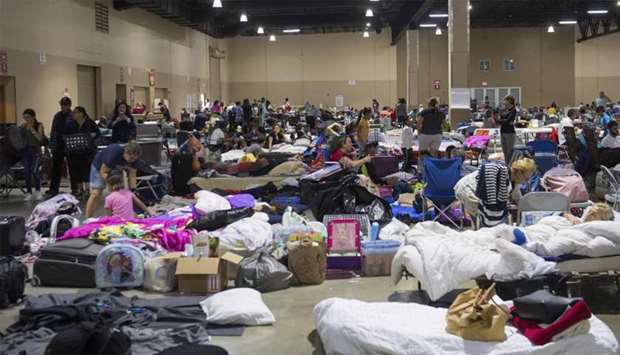Florida insurance companies have not been tested to see if they can withstand a historic storm like Hurricane Irma, and an industry expert warned that ‘all bets are off’ if the damage is as catastrophic as predicted.
The ferocious storm was expected to slam into Florida overnight Saturday, and had been upgraded to a maximum-strength Category Five storm went it struck Cuba late Friday.
Irma will cover the entire state, ripping through one of the most highly-developed regions in the United States, including the upscale areas around Miami, where hundreds of billions of dollars in real estate are at risk.
As a result, the disaster could leave some insurers struggling or unable to pay claims from policyholders as they dig out after what is expected to be one of the most destructive storms ever to hit the United States.
As of Friday morning, damage forecasts stood at around $100 billion, according to disaster modeling firm Enki Research.
Shahid Hamid, an expert on the insurance industry who oversees stress testing for Florida state regulators, told AFP he had serious concerns about the ability of local insurers to absorb a shock of this magnitude.
As director of the insurance labouratory at Florida International University's hurricane research center, Hamid tests companies to see whether their financial positions are secure enough to handle a flood of hurricane-related claims.
Although all companies passed the most recent round of testing, the stress tests did not contemplate the ‘exceptional scenario’ of a $100 billion storm, Hamid said.
- 'All bets may be off' -
‘This raises the question how many insurance companies can really cope with a hurricane like Irma,’ he said.
‘If the losses are exceptionally high, then all bets may be off.’
Officials at Florida's Office of Insurance Regulation said Friday they could not respond to AFP queries as their office was closed. But in a statement issued Wednesday, the office said it communicated with company executives to confirm their readiness for Irma.
Florida, a state prone to hurricanes, has seen considerable changes in its insurance market since Hurricane Andrew, which in 1992 dollars tore a $27 billion path through southern Florida.
After brand-name insurers like State Farm and Prudential fled the local market, Florida improved building codes to reduce storm damage and promoted reinsurance to cushion insurers from such claims.
The state also created an insurer of last resort known as Citizens Property Insurance Corporation.
Michael Peltier, a spokesman for Citizens, said about half of its 450,000 policies were concentrated in the southern counties of Broward, Miami-Dade and Palm Beach.
However, the company did not have estimates for potential damage or claims.
- A bigger threat than Andrew -
Steven Weisbart, chief economist at the Insurance Information Institute, an industry-supported body, told AFP he doubted any insurer would go belly up because of the storm.
‘It's unlikely that you will see a solvency event for insurers in the Florida market place,’ he said, and the industry overall is well capitalized, running a $700 billion surplus.
In the event a company did fail, US laws require surviving insurers to cover their liabilities, he said.
However, Hamid remained concerned.
About 70 percent of the buildings in southern Florida pre-date Hurricane Andrew and thus were not be built to the stricter, contemporary building codes -- and many of these were never retrofitted, he said.
And even those tougher requirements would be of little benefit in storms stronger than Categories 2 and 3.
‘While the insurance industry in Florida is in a much better position than at the time of Andrew, it is also facing a potentially much bigger threat in Hurricane Irma, provided the current forecast comes true,’ he said.
‘I hope that will not be the case. I am praying for a change in the hurricane track.’



